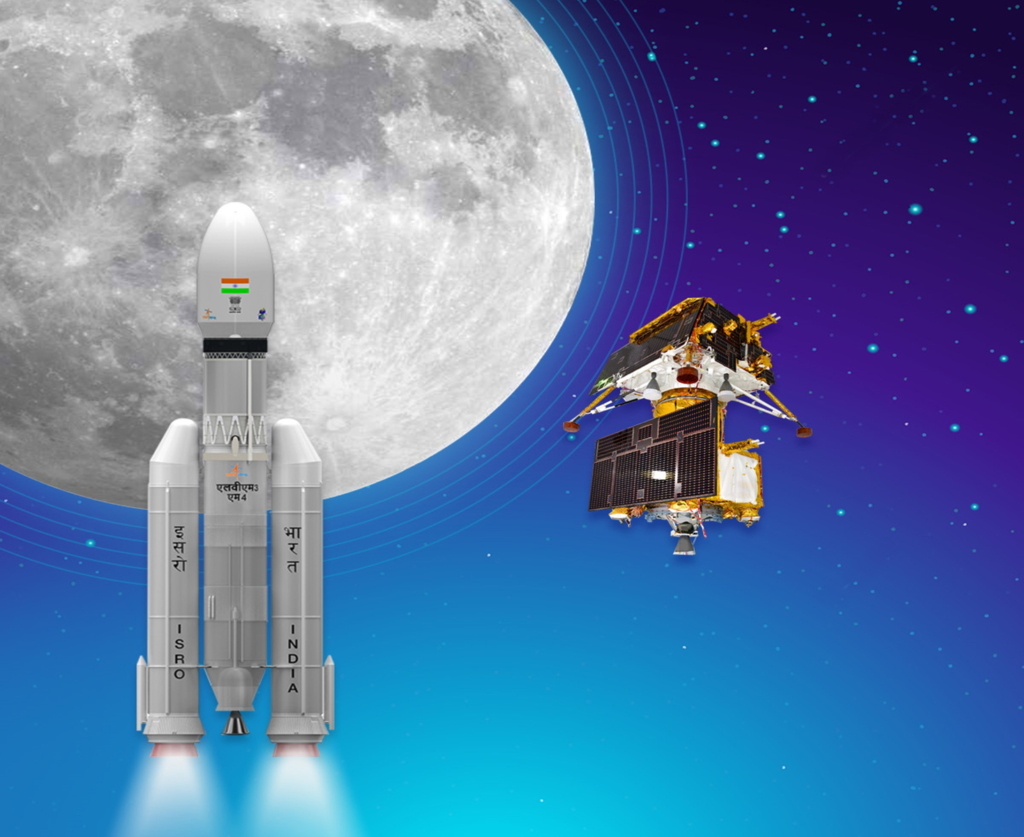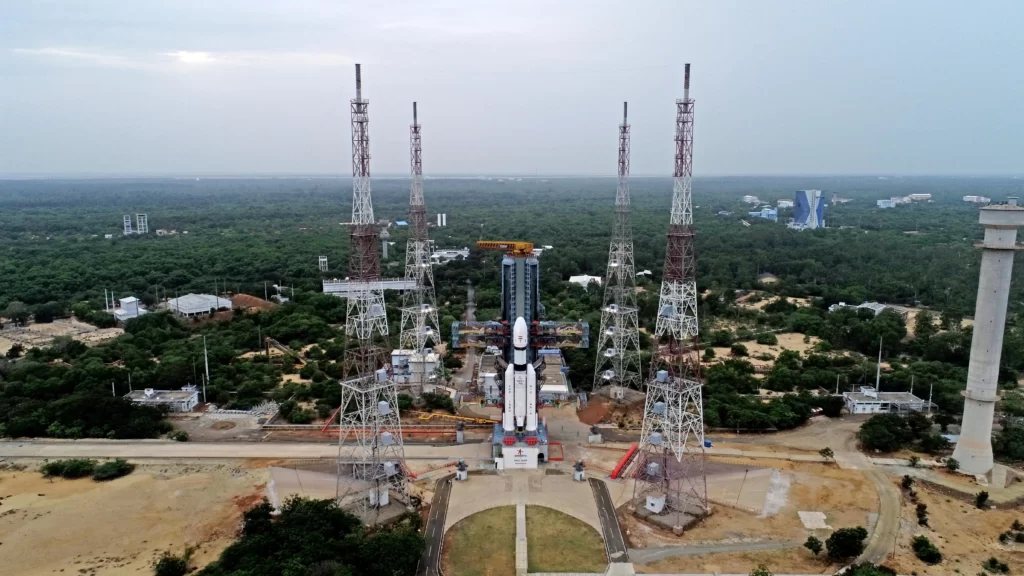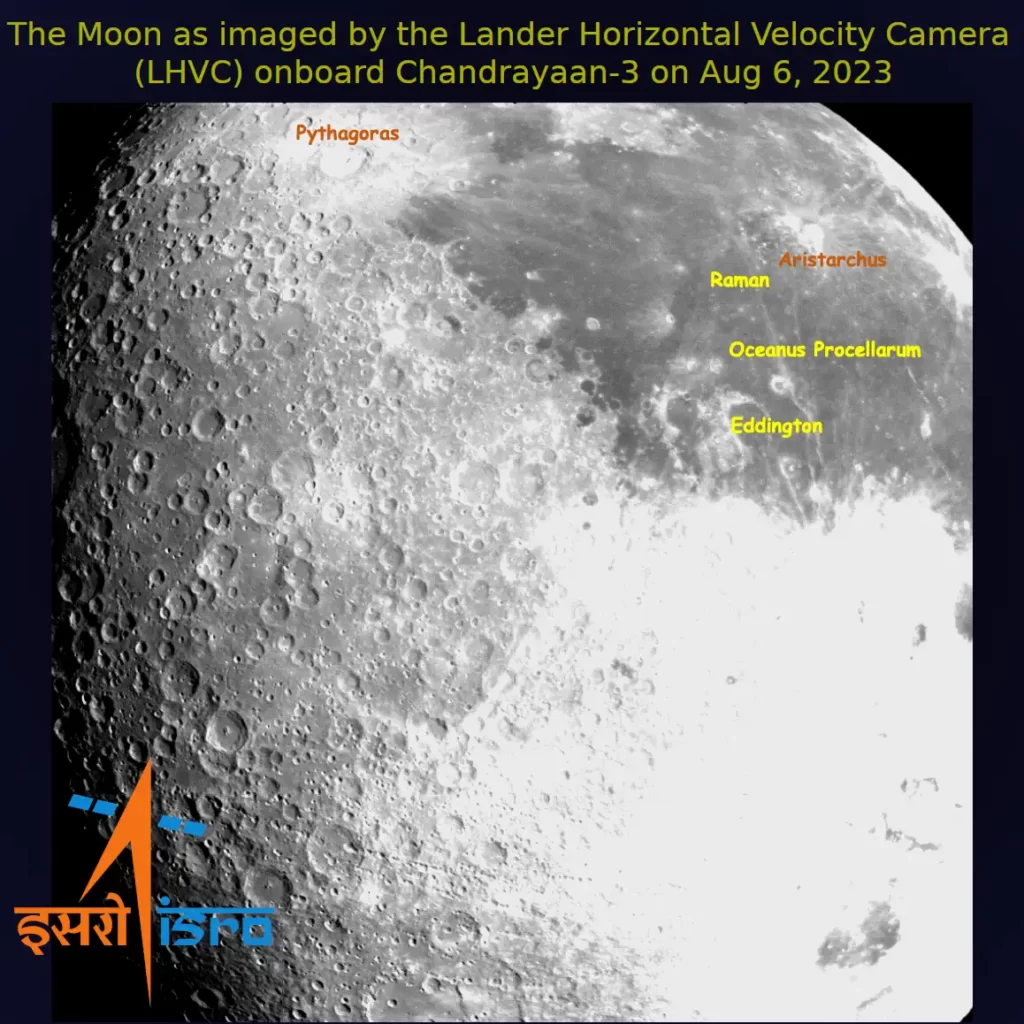CHANDRAYAAN 3 MISSION TO MOON

CHANDRAYAAN 3 MISSION TO MOON
The mission objectives of Chandrayaan-3 are
- To demonstrate Safe and Soft Landing on Lunar Surface
- To demonstrate Rover roving on the moon and
- To conduct in-situ scientific experiments
To achieve the mission objectives, several advanced technologies are present in Lander such as,
- Altimeters: Laser & RF based Altimeters
- Velocimeters: Laser Doppler Velocimeter & Lander Horizontal Velocity Camera
- Inertial Measurement: Laser Gyro based Inertial referencing and Accelerometer package
- Propulsion System: 800N Throttleable Liquid Engines, 58N attitude thrusters & Throttleable Engine Control Electronics
- Navigation, Guidance & Control (NGC): Powered Descent Trajectory design and associate software elements
- Hazard Detection and Avoidance: Lander Hazard Detection & Avoidance Camera and Processing Algorithm
- Landing Leg Mechanism.

About CHANDRAYAAN 3
Chandrayaan-3 mission to moon is a follow-on mission to Chandrayaan-2 to demonstrate end-to-end capability in safe landing and roving on the lunar surface. It consists of Lander and Rover configuration. It will be launched by LVM3 from SDSC SHAR, Sriharikota. The propulsion module will carry the lander and rover configuration till 100 km lunar orbit. The propulsion module has Spectro-polarimetry of Habitable Planet Earth (SHAPE) payload to study the spectral and Polari metric measurements of Earth from the lunar orbit.https://maximahealthy.com/

Lander payloads:
Chandra’s Surface Thermophysical Experiment (Cha STE) to measure the thermal conductivity and temperature; Instrument for Lunar Seismic Activity (ILSA) for measuring the seismicity around the landing site; Langmuir Probe (LP) to estimate the plasma density and its variations. A passive Laser Retroreflector Array from NASA is accommodated for lunar laser ranging studies.

Rover payloads:
Alpha Particle X-ray Spectrometer (APXS) and Laser Induced Breakdown Spectroscope (LIBS) for deriving the elemental composition in the vicinity of landing site.

Details of Chandrayaan 3
Chandrayaan-3 mission to moon consists of an indigenous Lander module (LM), Propulsion module (PM) and a Rover with an objective of developing and demonstrating new technologies required for Inter planetary missions. The Lander will have the capability to soft land at a specified lunar site and deploy the Rover which will carry out in-situ chemical analysis of the lunar surface during the course of its mobility. The Lander and the Rover have scientific payloads to carry out experiments on the lunar surface. The main function of PM is to carry the LM from launch vehicle injection till final lunar 100 km circular polar orbit and separate the LM from PM. Apart from this, the Propulsion Module also has one scientific payload as a value addition which will be operated post separation of Lander Module. The launcher identified for Chandrayaan-3 is LVM3 M4 which will place the integrated module in an Elliptic Parking Orbit (EPO) of size ~170 x 36500 km.

To demonstrate the above said advanced technologies in earth condition, several Lander special tests have been planned and carried out successfully viz
- Integrated Cold Test – For the demonstration of Integrated Sensors & Navigation performance test using helicopter as test platform
- Integrated Hot test – For the demonstration of closed loop performance test with sensors, actuators and NGC using Tower crane as test platform
- Lander Leg mechanism performance test on a lunar simulant test bed simulating different touch down conditions.
Integrated Module of CHANDRAYAAN 3 MISSION TO MOON


The overall specifications for CHANDRAYAAN 3 MISSION TO MOON is provided below
| Sl No. | Parameter | Specifications |
| 1. | Mission Life (Lander & Rover) | One lunar day (~14 Earth days) |
| 2. | Landing Site (Prime) | 4 km x 2.4 km 69.367621 S, 32.348126 E |
| 3. | Science Payloads | Lander: Radio Anatomy of Moon Bound Hypersensitive ionosphere and Atmosphere (RAMBHA) Chandra’s Surface Thermo physical Experiment (ChaSTE) Instrument for Lunar Seismic Activity (ILSA) Laser Retroreflector Array (LRA) Rover: Alpha Particle X-Ray Spectrometer (APXS) Laser Induced Breakdown Spectroscope (LIBS) Propulsion Module: Spectro-polarimetry of HAbitable Planet Earth (SHAPE) |
| 4. | Two Module Configuration | Propulsion Module (Carries Lander from launch injection to Lunar orbit) Lander Module (Rover is accommodated inside the Lander) |
| 5. | Mass | Propulsion Module: 2148 kg Lander Module: 1752 kg including Rover of 26 kg Total: 3900 kg |
| 6. | Power generation | Propulsion Module: 758 W Lander Module: 738W, WS with Bias Rover: 50W |
| 7. | Communication | Propulsion Module: Communicates with IDSN Lander Module: Communicates with IDSN and Rover. Chandrayaan-2 Orbiter is also planned for contingency link. Rover: Communicates only with Lander. |
| 8. | Lander Sensors | Laser Inertial Referencing and Accelerometer Package (LIRAP) Ka-Band Altimeter (KaRA) Lander Position Detection Camera (LPDC) LHDAC (Lander Hazard Detection & Avoidance Camera) Laser Altimeter (LASA) Laser Doppler Velocimeter (LDV) Lander Horizontal Velocity Camera (LHVC) Micro Star sensor Inclinometer & Touchdown sensors |
| 9. | Lander Actuators | Reaction wheels – 4 nos (10 Nms & 0.1 Nm) |
| 10. | Lander Propulsion System | Bi-Propellant Propulsion System (MMH + MON3), 4 nos. of 800 N Throttleable engines & 8 nos. of 58 N; Throttleable Engine Control Electronics |
| 11. | Lander Mechanisms | Lander leg Rover Ramp (Primary & Secondary) Rover ILSA, Rambha & Chaste Payloads Umbilical connector Protection Mechanism, X- Band Antenna |
| 12. | Lander Touchdown specifications | Vertical velocity: ≤ 2 m / sec Horizontal velocity: ≤ 0.5 m / sec Slope: ≤ 12 deg |

The objectives of scientific payloads planned on Chandrayaan-3 Lander Module and Rover are provided below
| Sl. No | Lander Payloads | Objectives | |
| 1. | Radio Anatomy of Moon Bound Hypersensitive ionosphere and Atmosphere (RAMBHA) | Langmuir probe (LP) | To measure the near surface plasma (ions and electrons) density and its changes with time |
| 2. | Chandra’s Surface Thermo physical Experiment (ChaSTE) | To carry out the measurements of thermal properties of lunar surface near polar region. | |
| 3. | Instrument for Lunar Seismic Activity (ILSA) | To measure seismicity around the landing site and delineating the structure of the lunar crust and mantle. | |
| 4. | LASER Retroreflector Array (LRA) | It is a passive experiment to understand the dynamics of Moon system. | |

| Sl. No | Rover Payloads | Objectives |
| 1. | LASER Induced Breakdown Spectroscope (LIBS) | Qualitative and quantitative elemental analysis & To derive the chemical Composition and infer mineralogical composition to further our understanding of Lunar-surface. |
| 2. | Alpha Particle X-ray Spectrometer (APXS) | To determine the elemental composition (Mg, Al, Si, K, Ca,Ti, Fe) of Lunar soil and rocks around the lunar landing site. |
| Sl. No | Propulsion Module Payload | Objectives |
| 1. | Spectro-polarimetry of HAbitable Planet Earth (SHAPE) | Future discoveries of smaller planets in reflected light would allow us to probe into variety of Exo-planets which would qualify for habitability (or for presence of life). |
Project Schedule of CHANDRAYAAN 3 MISSION TO MOON
August 24, 2023–Chandrayaan-3 ROVER: Made in India. Made for the MOON! The Ch-3 Rover ramped down from the Lander and India took a walk on the moon ! More updates soon. https://www.isro.gov.in/
August 23, 2023–‘I reached my destination and you too!’: Chandrayaan-3
Chandrayaan-3 has successfully soft-landed on the moon. Congratulations, India!
August 20, 2023–The Lander Module is in 25 km x 134 km orbit. Powered descent is expected to commence on August 23, 2023, around 1745 Hrs. IST
August 19, 2023–The Lander Module is in 113 km x 157 km orbit around the moon. Second de-boosting is planned for August 20, 2023
August 17, 2023–Lander Module is successfully separated from the Propulsion Module. De-boosting planned for August 18, 2023
August 16, 2023–The spacecraft is in an orbit of 153 km x 163 km after the firing on August 16, 2023
August 14, 2023–The mission is in the orbit circularization phase. The spacecraft is in 151 km x 179 km orbit
August 09, 2023–Chandrayaan-3’s orbit is reduced to 174 km x 1437 km following a manuevre performed on August 9, 2023
August 06, 2023–LBN#2 is successfully completed. The spacecraft is in 170 km x 4313 km orbit around the moon
August 05, 2023–Chandrayaan-3 is successfully inserted into the lunar orbit. The orbit achieved is 164 km x 18074 km, as intended.
August 01, 2023–The spacecraft is inserted into the translunar orbit. The orbit achieved is 288 km x 369328 km. Lunar-Orbit Insertion (LOI) is planned for Aug 5, 2023.
July 25, 2023–Orbit-raising maneuver performed on July 25, 2023. Next firing (Trans Lunar Injection), is planned for August 1, 2023.
July 22, 2023–The fourth orbit-raising maneuver (Earth-bound perigee firing) is completed. The spacecraft is now in a 71351 km x 233 km orbit.
July 17, 2023–The second orbit-raising maneuver performed. The spacecraft is now in 41603 km x 226 km orbit.
July 15, 2023–The first orbit-raising maneuver (Earthbound firing-1) is successfully performed at ISTRAC/ISRO, Bengaluru. Spacecraft is now in 41762 km x 173 km orbit.
July 14, 2023–LVM3 M4 vehicle successfully launched Chandrayaan-3 into orbit. Chandrayaan-3, in its precise orbit, has begun its journey to the Moon. Health of the Spacecraft is normal.
July 11, 2023–The ‘Launch Rehearsal’ simulating the entire launch preparation and process lasting 24 hours has been concluded.
July 07, 2023–Vehicle electrical tests completed. Citizens are invited to witness the launch from the Launch View Gallery at SDSC-SHAR, Sriharikota, by registering at here
July 06, 2023–The launch is scheduled for July 14, 2023, at 14:35 Hrs. IST from the Second Launch Pad, SDSC-SHAR, Sriharikota.